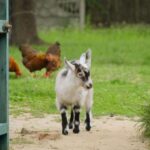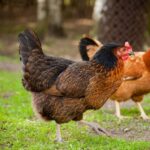Brahma chickens are the superstars of the backyard chicken world.
They’re one of the largest breeds, they always turn heads, they have funny fluffy legs, and huge personalities to match.
As with most chicken breeds, however, Brahma’s have an interesting history and there’s a lot more to them than just being giant chickens.
Here are some of the most interesting and fun facts about Brahma chickens!
Table of Contents
15 Facts About Brahma Chickens
- The exact origin of the Brahma isn’t known, but we do know it originated in America as a result of crossbreeding with large chickens from China.
- In 1852, records show that Brahmas were exported to England by Mr. George Burnham where the Dark Brahma variety was created.
- They are considered a heritage breed, which means they were established prior to the mid-20th century.
- Brahmas are not the most prolific layers. You can expect around 3 eggs a week, that’s about 150 eggs per year.
- They lay medium-sized brown eggs. Not super large eggs like you may expect from such a big bird!
- They are considered to be “superior winter-layers”, meaning they lay well throughout winter when some breeds stop laying.
- Typically, they take about 6 months to mature and start laying. Waiting 9-12 months is not uncommon either.
- Brahma chickens are feather legged. This has some pros and cons, there is some care required to stop issues such as frostbite, mites, and mud clumping.
- They have a distinctive head shape and a pea comb that makes them easily identifiable.
- The American Standard of Perfection, which is the official breed standard for poultry fancy in North America, recognizes three colors of Brahma; light, dark, and buff.
- Brahma hens typically weigh around 9-10 lbs, and the roosters are around 12 lbs. Making them one of the heaviest chicken breeds.
- They are known for their placid and friendly personalities. They are big softies at heart!
- They are weather-hardy, from extreme cold to extreme heat - Brahmas adapt well and are just fine.
- Brahmas come in a bantam size too. If they’re too big but you’re in love with their look and personality, check out a bantam.
- Their life expectancy is 7-9 years.
Never actually seen a large Brahma rooster for yourself? Check out the video below:
Are Brahmas a Good Backyard Chicken?
They are great backyard chickens, yes.
I hope you now realize there’s a lot more to this breed than the novelty of being one of the largest breeds of chickens.
They are super friendly, big softies if you like, and make really lovable pets. Oh, and don’t forget, they’re chickens so you’re going to get delicious eggs!
The only thing I’d say is that they’re not ideal for beginners. There are easier breeds to raise, like Rhode Island Reds or Black Stars.
But they aren’t difficult or anything, don’t let me put you off if you have your heart set on raising some Brahmas.
They’re not the most prolific layers either. So, I think it’s fair to say that they are best suited to people who want to be involved with raising chickens and enjoy the process more than just collecting eggs.
Related Questions:
Are All Brahma Chickens Big?
They are yes, you can expect a Brahma hen to grow to about 30 inches tall and weigh up to 10 lbs. While the roosters are slightly bigger and can weigh up to 12 lbs.
There are, of course, Brahma bantams that are about half the size or less. Bantams are super-cute and give people with less space the chance to enjoy all the benefits of a certain breed in miniature form.
Are Brahma Chickens Good Layers?
They aren’t prolific layers, no. Brahmas typically lay around 150 eggs a year. That puts them well behind breeds like the Rhode Island Red and California White that produce 250-300.
Something they do have going for them is that they are good winter layers. Some breeds will not lay during the winter months when it’s cold and daylight hours are short, but Brahams don’t stop.
Interested in more chicken facts? Check out a couple of the most popular posts:
Facts about Wyandotte chickens
Facts about Black Star chickens
Image credits - Header photo by Leonardo Iheme on Unsplash




